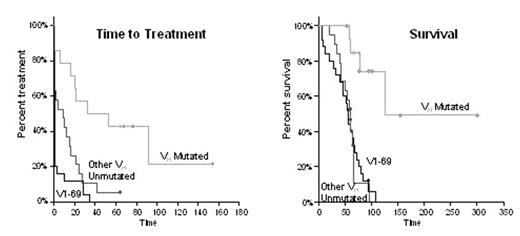Abstract
The mutational status of the immunoglobulin variable heavy chain genes (VH) is a major prognostic indicator in patients with CLL. More recently, additional prognostic categories have been identified by recognizing disease subsets which utilize unique VH genes. Examples include the V3-21 and V3-72 genes which are invariably associated with progressive and stable disease, respectively. The V1–69 gene is the most frequently rearranged VH gene in CLL and is almost always unmutated. We therefore investigated whether CLL patients that express this VH gene differ in clinical course and outcome with respect to CLL patients expressing other unmutated VH genes. The study group consisted of 106 consecutive CLLs that had been diagnosed at our institution prior to 2000. The 25 V1–69 cases (23.6%) were identified by allele-specific VH gene fingerprinting and all were found to be unmutated by nucleotide sequencing. Forty of the remaining cases were randomly selected for VH gene nucleotide sequence analysis; 19 cases expressed another unmutated VH gene, 14 cases expressed a mutated VH gene and the VH gene sequence could not be determined in 7 cases. The V1–69 cases did not differ significantly from cases with other unmutated VH genes with respect to age (median age 60 years for both subgroups), gender (male: female=21:4 for V1–69 cases and 13:6 for other VH unmutated cases, P=n.s.) and median follow-up (V1–69 cases: median 56 months, range 6 to 109; other VH unmutated cases: median 59 months, range 20 to 97, P=n.s.). The percentage of cases presenting at an advanced stage was higher in the V1–69 subgroup (36% of cases in Rai high risk category) than in the subgroup with other unmutated VH genes (5% of cases in Rai high risk category, P=0.027), whereas no significant difference was observed with respect to Ly counts and total tumor burden at diagnosis. Interestingly, 80% of the V1–69 cases compared to 42% of cases with other unmutated VH genes had received treatment immediately following diagnosis, but median time to treatment was not significantly different between the two subgroups (1 month vs. 9 months, respectively, P=0.085). To date 24 V1–69 cases (96%) and 15 cases with other unmutated VH genes (79%) have died, with median survival times of 56 and 60 months, respectively (P=0.9). For comparison, median survival of the 14 VH mutated cases from this series was 125 months (P<0.0001 with respect to both subgroups with unmutated VH genes). We therefore conclude that chronic lymphocytic leukemia patients with a V1–69 gene rearrangement constitute a uniform group with unfavorable prognosis, but their survival does not differ significantly from patients with other unmutated VH genes.
Author notes
Corresponding author


This feature is available to Subscribers Only
Sign In or Create an Account Close Modal